weather.com meteorologists
November starts the transition between fall and winter which often means changing and interesting weather conditions are ahead.
Here's a look at some of the gloomy and no so gloomy weather November can bring to the Lower 48.
Snow Arrives and Ramps Up
The average first measurable snow (defined as at least 0.1 inches) typically arrives in November for many cities in the Northeast, Midwest and West.
A few of the cities that historically experience the first snow of the season in November include Boston (Nov. 29), Chicago (Nov. 18), Cleveland (Nov. 10), Pittsburgh (Nov. 17) and Salt Lake City (Nov. 8).
Snow also increases in the higher elevations of the West as November progresses.
(MORE: Here's When Winter Weather Typically Arrives)
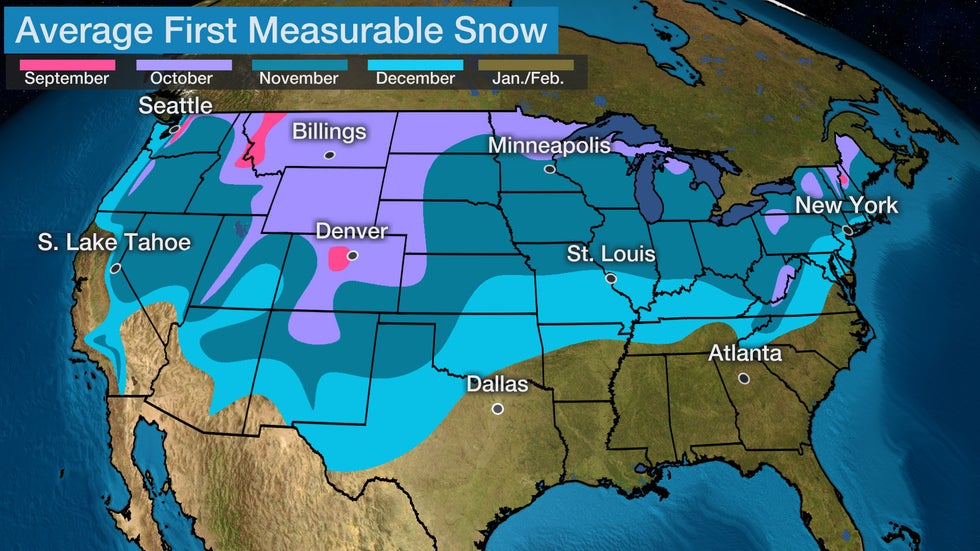 Month of the average first measurable (0.1 inches or greater) snowfall of the season, according to 30-year average statistics from 1981-2010. In parts of the South, measurable snow is most likely to occur in January or February, but not every year.
Month of the average first measurable (0.1 inches or greater) snowfall of the season, according to 30-year average statistics from 1981-2010. In parts of the South, measurable snow is most likely to occur in January or February, but not every year.Lake-effect snow bands also become more common downwind of the Great Lakes. Cold air flowing over relatively warm water in the Great Lakes is the key mechanism for lake-generated precipitation and cold air becomes more abundant later in fall.
Great Lakes snowbelt cities such as Buffalo, New York, and Grand Rapids, Michigan, typically pick up 6 to 9 inches of snow each November. Marquette, in Michigan's Upper Peninsula, gets about two feet of snow in an average November.
Clouds, Clouds and More Clouds
November is usually the cloudiest month of the year in parts of the Northern Plains and upper Midwest, including the Twin Cities and Milwaukee, Wisconsin, according to climatologist Brian Brettschneider. The cloudy peak arrives in December in other parts of the Midwest and Northeast, but November kicks off all the gloom.
An average November sky is at least 70% cloud-covered around the Great Lakes, interior Northeast and Pacific Northwest.
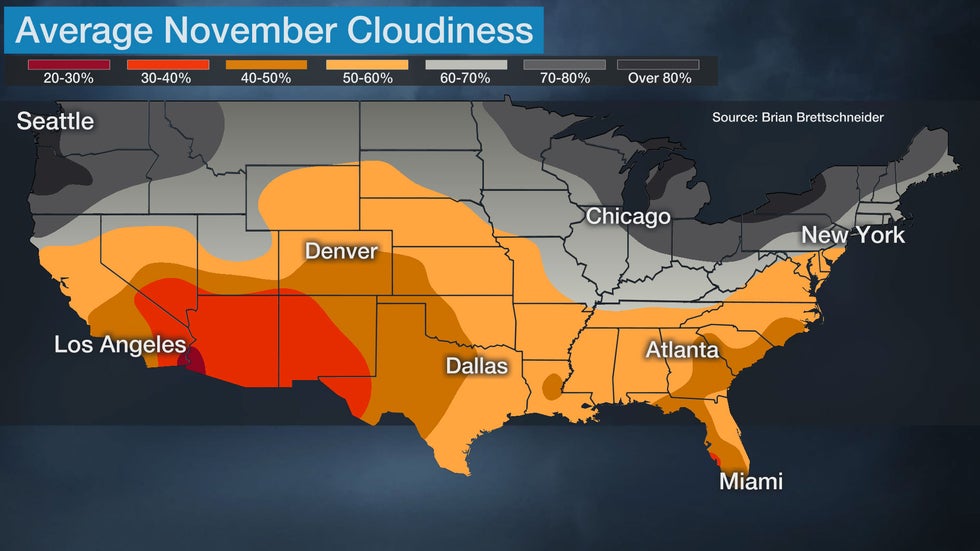 Average November cloudiness from 1966 to 1996.
Average November cloudiness from 1966 to 1996.Severe Weather
November has often been a dangerous month for severe weather outbreaks because conditions can be favorable to support them.
Jet stream winds become stronger in the fall, and warm, moist air is available at times. The atmosphere can become unstable and result in severe thunderstorms with damaging winds, large hail and occasional tornadoes.
Most of the time these fall tornado outbreaks occur in the Deep South, where warm, moist air is more common, but they can sometimes spread farther north.
The largest fall tornado outbreak struck the South Nov. 21-23, 1992. A total of 105 tornadoes touched down in three days, killing 26 people.
(MORE: Tornadoes and Severe Thunderstorms Aren't Just For Spring And Summer)
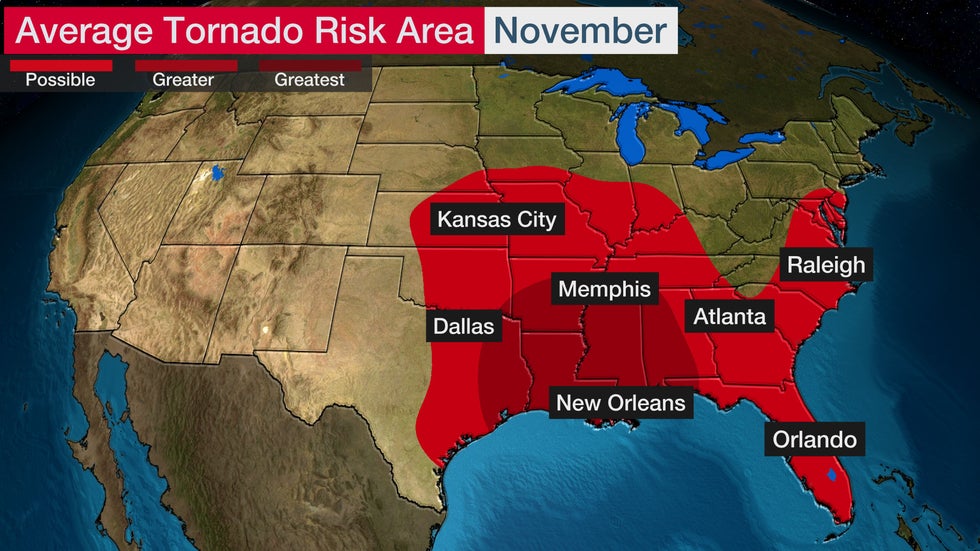 The highest chance of tornadoes in November is near the Gulf Coast.
The highest chance of tornadoes in November is near the Gulf Coast.Finally, The End
November is the last month of the Atlantic hurricane season, but both the number of named storms and risk to the U.S. is much lower than earlier in the fall.
One named storm typically forms every other November somewhere in the Atlantic Basin.
Only three hurricanes have struck the U.S. in November. Hurricane Kate made landfall in Florida days before Thanksgiving 1985, marking the latest hurricane landfall in U.S. history.
But other parts of the Atlantic Basin haven't been so lucky in November, especially recently.
Two Category 4 hurricanes - Eta then Iota - struck Nicaragua within 15 miles of each other just 13 days apart in November 2020.
In 2016, Hurricane Otto was the Atlantic Basin's latest in season landfall on record when it moved into southern Nicaragua at Category 3 strength on America's Thanksgiving Day.
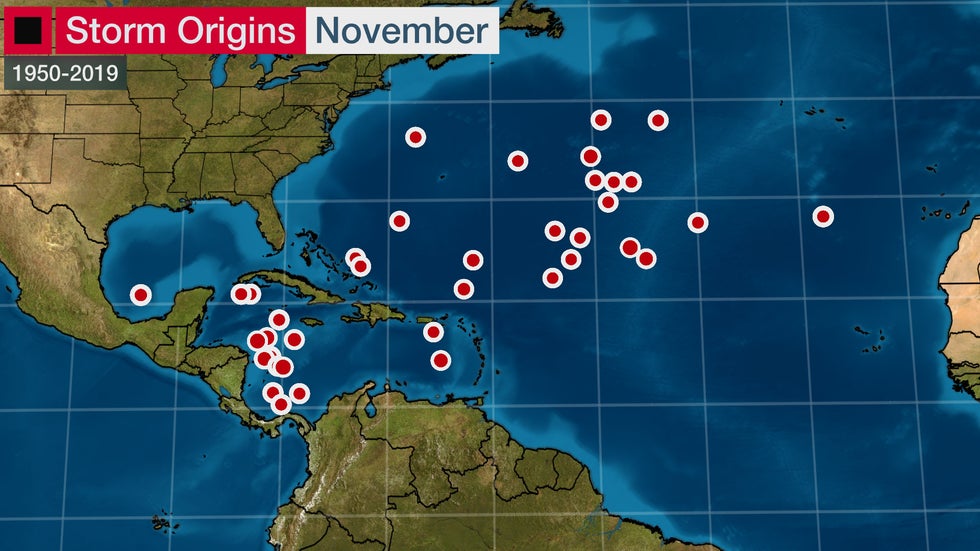 Tropical cyclone origins in November based on data from 1950-2019.
Tropical cyclone origins in November based on data from 1950-2019.Florida's Dry Season Begins
Floridians enjoy the arrival of the state's dry season by November. Florida typically dries out by late October and it stays dry through early spring as cold fronts return.
Days can still be warm, but by November, the humidity is lower and temperatures usually cool down at night.
Behind these fronts, cooler air near the surface stabilizes the atmosphere, suppressing the almost daily showers and thunderstorms seen in the summer.
This does not mean Florida stays completely dry, but that the amount of precipitation is notably less than during the wet season.
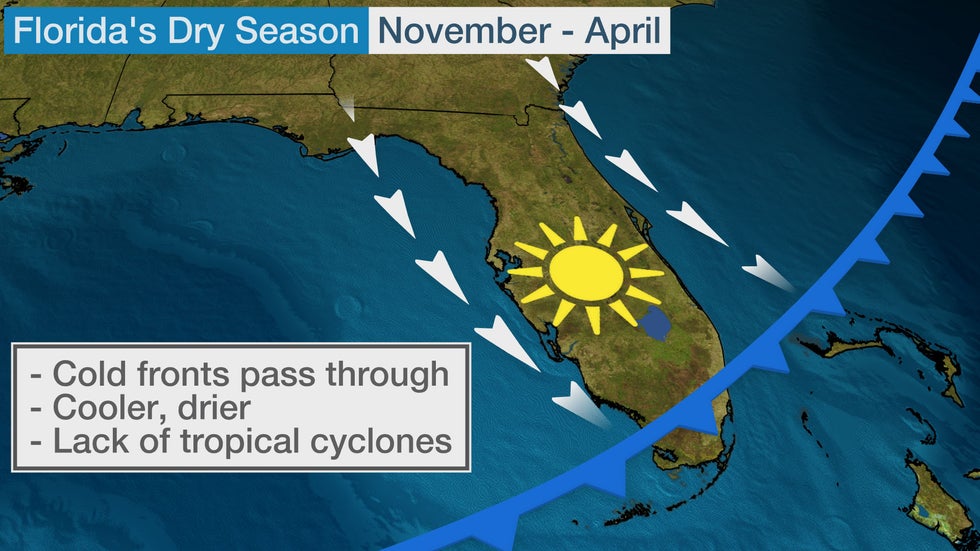 Dry season setup in Florida.
Dry season setup in Florida.Wet West
November marks the intensification of the wet season along the West Coast.
For Portland, Oregon, and Seattle, November averages more precipitation than any other month during the year.
California's wet season typically ramps up by November as the jet stream gradually shifts southward. This first rain can finally provide a break for fatigued fire crews and first responders. Skiers and snowboarders also love these November storms in the West, as they build up snowpack.
As Pacific storm systems plow inland, they can occasionally tap into a so-called atmospheric river (a narrow plume of moisture extending into the tropics or subtropics). This extra moisture can result in heavy rainfall that can cause flooding and debris flows.
 California's wet season kicks into gear by November.
California's wet season kicks into gear by November.Watch For November 'Witch' Storms
Storm systems that develop in the fall are stronger due to increasing temperature contrasts from north to south across the country. The more intense these low-pressure systems become, the stronger the winds they can produce.
Early November, as well as late October, has a long, notorious history of intense Midwest windstorms. The "Witches of November" are sometimes used to describe these storms that often pack powerful winds.
Winds from these storms often cause tree damage and power outages. The storms are also a major hazard for shipping on the Great Lakes. One of the most well-known witch storms sank a huge iron-ore ship called the Edmund Fitzgerald while it was on Lake Superior in November 1975.
 GOES-16 GeoColor satellite images taken at 8 a.m. EDT, Oct. 23, 2017 (first image), then 24 hours later, showing the bombogenesis of a Great Lakes storm. (Note: City lights overlay is applied in these images)
GOES-16 GeoColor satellite images taken at 8 a.m. EDT, Oct. 23, 2017 (first image), then 24 hours later, showing the bombogenesis of a Great Lakes storm. (Note: City lights overlay is applied in these images)The Weather Company’s primary journalistic mission is to report on breaking weather news, the environment and the importance of science to our lives. This story does not necessarily represent the position of our parent company, IBM.
The Weather Company’s primary journalistic mission is to report on breaking weather news, the environment and the importance of science to our lives. This story does not necessarily represent the position of our parent company, IBM.

No comments:
Post a Comment